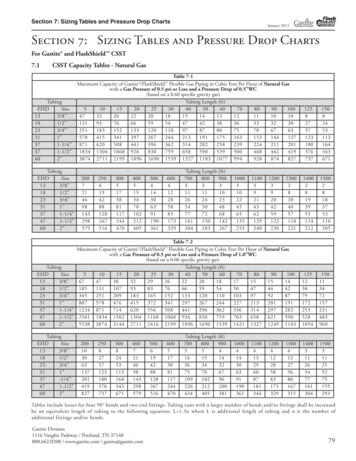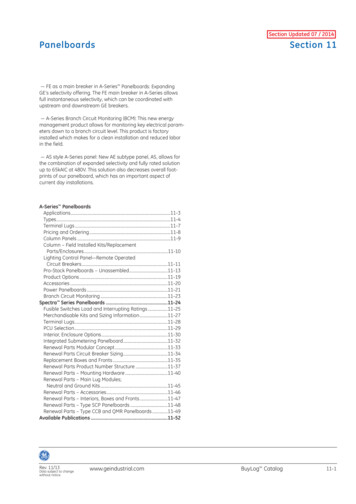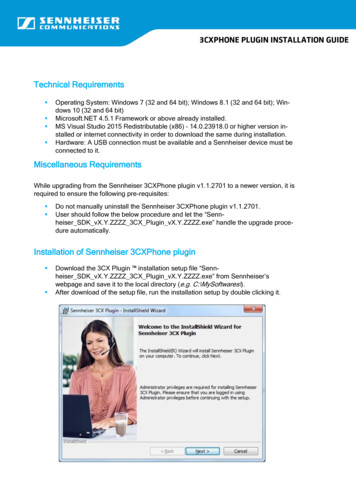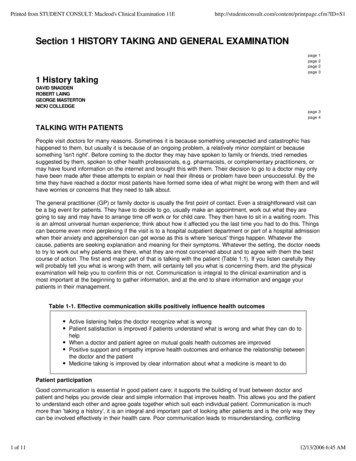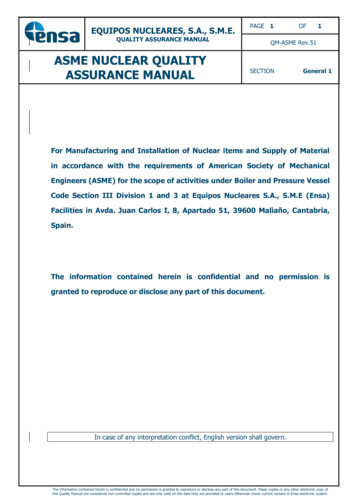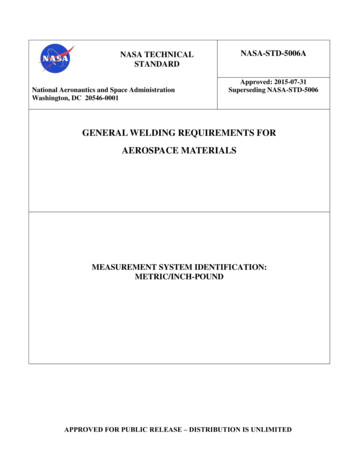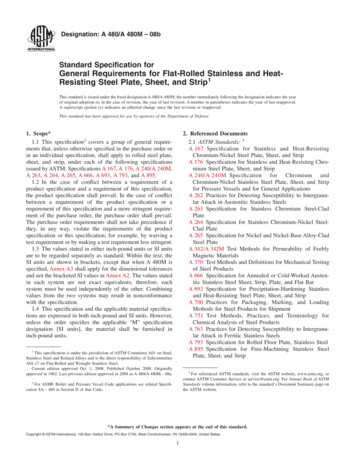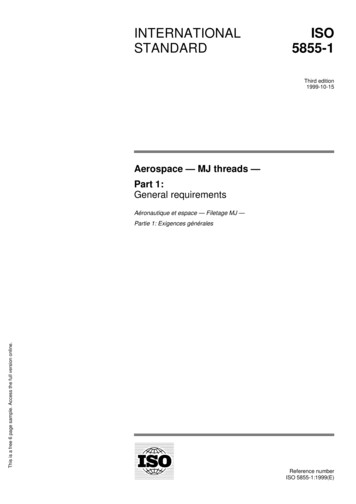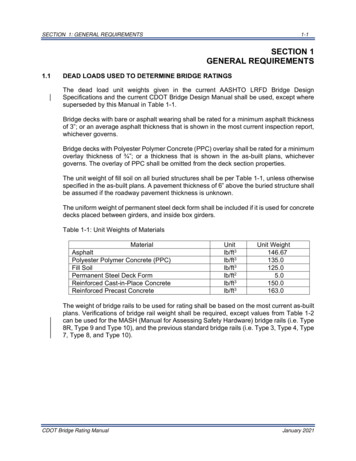
Transcription
SECTION 1: GENERAL REQUIREMENTS1-1SECTION 1GENERAL REQUIREMENTS1.1DEAD LOADS USED TO DETERMINE BRIDGE RATINGSThe dead load unit weights given in the current AASHTO LRFD Bridge DesignSpecifications and the current CDOT Bridge Design Manual shall be used, except wheresuperseded by this Manual in Table 1-1.Bridge decks with bare or asphalt wearing shall be rated for a minimum asphalt thicknessof 3”; or an average asphalt thickness that is shown in the most current inspection report,whichever governs.Bridge decks with Polyester Polymer Concrete (PPC) overlay shall be rated for a minimumoverlay thickness of ¾”; or a thickness that is shown in the as-built plans, whichevergoverns. The overlay of PPC shall be omitted from the deck section properties.The unit weight of fill soil on all buried structures shall be per Table 1-1, unless otherwisespecified in the as-built plans. A pavement thickness of 6” above the buried structure shallbe assumed if the roadway pavement thickness is unknown.The uniform weight of permanent steel deck form shall be included if it is used for concretedecks placed between girders, and inside box girders.Table 1-1: Unit Weights of MaterialsMaterialAsphaltPolyester Polymer Concrete (PPC)Fill SoilPermanent Steel Deck FormReinforced Cast-in-Place ConcreteReinforced Precast it Weight146.67135.0125.05.0150.0163.0The weight of bridge rails to be used for rating shall be based on the most current as-builtplans. Verifications of bridge rail weight shall be required, except values from Table 1-2can be used for the MASH (Manual for Assessing Safety Hardware) bridge rails (i.e. Type8R, Type 9 and Type 10), and the previous standard bridge rails (i.e. Type 3, Type 4, Type7, Type 8, and Type 10).CDOT Bridge Rating ManualJanuary 2021
SECTION 1: GENERAL REQUIREMENTS1-2Table 1-2: Unit Weights of Standard Rail SystemsRail TypeType 8R MASHType 9 MASHType 9, style CC MASHType 10 MASHType 3Type 4Type 7Type 7, style C-CType 8Type 10 (10, 10M, 10R)Structural Steel(lb/ft)Concrete Curb .4437.4244.4282484759290187426482538464290(*) The concrete curb weights are computed from the Figure 1-1. The concrete curb weightshall be re-computed if the existing curb geometry is different.Figure 1-1MASH Bridge RailsCDOT Bridge Rating ManualJanuary 2021
SECTION 1: GENERAL REQUIREMENTS1-3Figure 1-1 (Continue)Old Standard Bridge RailsCDOT Bridge Rating ManualJanuary 2021
SECTION 1: GENERAL REQUIREMENTS1.21-4LIVE LOADS USED TO DETERMINE BRIDGE RATINGSColorado Bridge Ratings are required at three different levels: Design Load Rating, LegalLoad Rating, and Permit Load Rating and shall be reported on the Rating Summary Sheet.The vehicles of three levels are as specified hereon and in the current AASHTO Manualfor Bridge Evaluation.These three different levels shall be used to compute the load ratings for all structure typesand for all 3 rating methods: Allowable Stress Rating (ASR), Load Factor Rating (LFR),and Load and Resistance Factor Rating (LRFR).1.2.1Design Load Rating LevelA) For ASR and LFR methods: The HS20-44 Loading consisting of a Standard HS20Truck or Standard Lane Load shall be used when computing the Inventory andOperating Load Ratings in US tons. See Figure 1-2.B) For LRFR method: The HL-93 Design Load shall be used when computing theInventory and Operating Rating Factors. See Figure 1-3.Additional HL-93 Load Models: 90% of Design Truck pair that is spaced a minimum of 50 feet between the leadaxle of one truck and the rear axle of the other truck, combined with 90% of theDesign Lane Load shall be used to compute the ratings factor at the pier(s) fornegative moment. For steel bridges, the fatigue truck shall be required to compute the Inventory RatingFactor. The fatigue truck consists of one design truck, similar to the truck in Figure1-3, but with a constant spacing of 30 feet between the 32-kip axles.1.2.2 Legal Load Rating LevelThe Legal Vehicles are required to be used when computing the Operating Load Ratingin US tons. The structure is required to be posted when the load rating is less than thegross vehicle weight limit.A) Colorado Legal Vehicles: Colorado Legal Trucks of Type 3, Type 3S2, and Type 3-2 shall be used for bridgeson State highway routes or Interstate business routes. See Figure 1-4. Interstate Legal Trucks of Type 3, Type 3S2, and Type 3-2 are State-SpecificVehicles modified from the AASHTO and the Colorado Legal Loads. See Figure1-5. These Interstate Legal trucks shall be used for bridges on Interstate highwayroutes or Interstate access ramps.Legal Vehicles are composed of the maximum vehicle loads allowed by law in Colorado.The difference between the live loads in Figures 1-4, and 1-5, is due to the maximumlegal loads allowed on Interstate highways being different from those allowed on otherColorado roadways.B) Specialized Hauling Vehicles (SHV): Notional Rating Load (NRL). See Figure 1-6. Single Unit Bridge Posting Loads of SU4, SU5, SU6 and SU7. See Figure 1-6.C) FAST Act’s Emergency Vehicles (Fixing America’s Surface Transportation Act): Emergency Vehicles of EV2 and EV3 are Notional vehicles. See Figure 1-7.NOTE: AASHTO Legal Loads of Type 3, Type 3S2 and Type 3-3, and AASHTO Lane-TypeLegal Load Model are NOT required for load ratings.CDOT Bridge Rating ManualJanuary 2021
SECTION 1: GENERAL REQUIREMENTS1-51.2.3 Permit Load Rating LevelThe Operating Load Ratings in US tons of the Permit Load Rating Vehicles shall be usedto determine the Color Code of the bridge. See Subsection 1.16.A) Colorado Permit Vehicle. See Figure 1-8.The Colorado Permit Vehicle is also required to be used for the design of newbridges for AASHTO LRFD Load Combination Strength II. Therefore, the ColoradoPermit Trucks’ configurations are currently used to institute the Colorado maximumallowable permit weight per axle group.B) Colorado Modified Tandem Vehicle. See Figure 1-8.CDOT Bridge Rating ManualJanuary 2021
SECTION 1: GENERAL REQUIREMENTS1-6HS20-44 LoadingUsed to determine the Inventory and Operating load ratings in US tonsFigure 1-2CDOT Bridge Rating ManualJanuary 2021
SECTION 1: GENERAL REQUIREMENTS1-7HL-93 Design Load - Notional VehicleUsed to determine the Inventory and Operating rating factorsFigure 1-3CDOT Bridge Rating ManualJanuary 2021
SECTION 1: GENERAL REQUIREMENTS1-8Colorado Legal TrucksUsed to determine the Operating load ratings in US tons along Colorado State HighwaysTruck width: 10’-0”Axle gage width: 6’-0”Figure 1-4CDOT Bridge Rating ManualJanuary 2021
SECTION 1: GENERAL REQUIREMENTS1-9Interstate Legal TrucksUsed to determine the Operating load ratings in US tons along Interstate HighwaysTruck width: 10’-0”Axle gage width: 6’-0”Figure 1-5CDOT Bridge Rating ManualJanuary 2021
SECTION 1: GENERAL REQUIREMENTS1-10Specialized Hauling VehiclesUsed to determine the Operating load ratings in US tonsTruck width: 10’-0”Axle gage width: 6’-0”A. Notional Rating Load (NRL)B. Single Unit Bridge Posting LoadsGVW Gross Vehicle WeightFigure 1-6CDOT Bridge Rating ManualJanuary 2021
SECTION 1: GENERAL REQUIREMENTS1-11Emergency Vehicles – Notional VehiclesUsed to determine the Operating load ratings in US tonsTruck width: 10’-0”Axle gage width: 6’-0”GVW Gross Vehicle WeightFigure 1-7CDOT Bridge Rating ManualJanuary 2021
SECTION 1: GENERAL REQUIREMENTS1-12Colorado Permit TrucksUsed to determine the Operating load ratings in US tonsTruck width: 10’-0”Axle gage width: 6’-0”Figure 1-8CDOT Bridge Rating ManualJanuary 2021
SECTION 1: GENERAL REQUIREMENTS1.31-13IMPACT, LOAD FACTOR, AND DISTRIBUTION OF LIVE LOADSThe live load impact used for rating shall be as specified in the current AASHTO LRFDand Standard Specifications for Highway Bridges, as applicable, except as noted. The liveload impact shall be applied for all bridge types, except to timber bridges.The live load distribution factors used for rating shall be as specified in the currentAASHTO LRFD and Standard Specifications for Highway Bridges, except as noted andelsewhere in the manual.The load factors used for rating shall be as specified in the Standard Specifications forHighway Bridges and the current AASHTO Manual for Bridge Evaluation, except as notedand elsewhere in the CDOT Rating Manual.A) Based on CDOT historical practice of overload permit analysis using LFR method(e.g., gross vehicle weight over 200,000 lbs), when reduced vehicle speed to 10 mphis enforced, impact can be reduced by 67% when crossing the structure.B) Impact shall not be considered for timber bridges.C) For bridges constructed or rehabilitated after 1985, all ratings shall use multi-lane liveloaded distribution factor.D) For bridges constructed in 1985 or earlier, rating and re-rating for Legal Load vehiclesand Colorado Permit vehicles may be performed using a single lane live loaddistribution factor. The vehicle may be assumed to occupy the center of a single drivinglane without concurrent live loading in any other lane. Non-redundant (fracture-critical)structures shall only utilize multi-lane live loaded distribution factors due to thelikelihood of failure of entire structure if one part fails. The design vehicle ratings shallbe rated with multi-lane live load distribution factor.E) When bridge geometric constraints (e.g., span length, number of girder and girderspacing) are outside the range of live load distribution formulas specified in theAASHTO Specifications, the lever rule method or other software may be used tocalculate the live load (single or multi-lane) distribution factors.F) When the lever rule method is used to determine distribution factors for exteriorstringers, exterior deck girders, through girders, and trusses, place the first truck wheel2’-0” from the front face of curb or railing. The transverse distance from centerline tocenterline of the standard gage trucks shall be 12’-0” or the width of one traffic lane fornarrow bridges.G) For any load rating methods, the placement of the wheel load shall be 1 foot from theface of the curb or railing for rating of deck overhang, and 2 feet for rating of girders.H) For LFR load ratings, when ratings for Legal or the Permit vehicles are less than thegross vehicle weight limits, the Rater may use the refined distribution factor analysisto improve the load ratings.CDOT Bridge Rating ManualJanuary 2021
SECTION 1: GENERAL REQUIREMENTS1-14I)For LRFR load ratings, the refined distribution factor method is not allowed for loadratings of bridges, except if it is approved in advance by the Staff Bridge RatingEngineer.J)Live load distribution factors for two-girder bridge systems and trusses shall becalculated using the lever rule method.K) The distribution of non-composite and composite dead loads shall be as specified inthe current CDOT Bridge Design Manual.L) A live load factor of 1.3 for operating rating may be used for emergency vehicles on alllevels of traffic volume for LRFR and LFR methods.M) For all buried pipe/arch culverts and CBCs, the LRFR live load factor for operatingrating of 1.35 shall be used for design vehicle, 2.0 for legal loads, and 1.4 for permitloads on all levels of traffic volume. Only the single loaded lane with multiple presencefactor of 1.0 may be used for legal load and permit load ratings; while 1.2 is used fordesign load rating.N) Distribution of wheel loads through earth fills shall be neglected where the depth of fillexceeds the limits as specified in the current AASHTO LRFD, Section 3.6.1.2.6.O) The Emergency Vehicles may be performed using a single lane live load distributionfactor for existing or new bridges.P) For reinforced and prestressed concrete structures, the service I & III limit states maybe ignored in ratings for the Legal and Permit Vehicles.1.4STRUCTURAL ANALYSIS METHODS USED TO DETERMINE BRIDGE RATINGSThe load ratings shall include analysis of the superstructure for components defined asprimary members such as girders, in-span hinges, stringers, deck, truss, floor-beams,truss connections, etc. The substructures / foundations will not be required for load ratingsexcept as requested by the Bridge Inspection Engineer, being necessary due to vehicleimpact and scour substructure elements, etc.Major structures (i.e. total span length greater than 20 feet) are required to have loadratings, and minor structures (i.e. span length from 4 feet to less than or equal to 20 feet)will be required to have load ratings per Subsection 1.8.A) All bridges designed with LRFD method or designed after September 30th, 2010 shallbe rated or re-rated with LRFR method.B) All existing ASD & LFD bridges designed before October 1st, 2010, except existingtimber bridges, shall be rated or re-rated with LFR or LRFR methods.C) All timber bridges shall be rated or re-rated with ASR method.D) All existing buried pipe/arch culverts may be rated or re-rated with LFR or LRFRmethods. New buried culverts shall be rated with LRFR method.CDOT Bridge Rating ManualJanuary 2021
SECTION 1: GENERAL REQUIREMENTS1-15E) For multiple lines of buried pipe structure that meets the minimum spacing betweenpipes per AASHTO LRFD, Section 12.6.7, a single pipe instead of multi-pipe may bemodeled for load rating analysis.F) All existing concrete and metal plank decks of bridges designed before October 1st,2010, shall be rated or re-rated with LFR method. Bridges constructed with partial orfull-depth precast pre-stressed concrete decks are not required for ratings except asrequested.G) All concrete decks of bridges designed after September 30th, 2010 are not required tobe rated except as requested. New metal plank decks shall be rated with LRFRmethod.H) All decks shall be rated for design trucks only.I)When existing bridges are re-decked, the girders shall be re-rated with the samemethod used to design the new deck, except if approved in advance by the Br
A) For ASR and LFR methods: The HS20-44 Loading consisting of a Standard HS20 Truck or Standard Lane Load shall be used when computing the Inventory and Operating Load Ratings in US tons. See Figure 1-2. B) For LRFR method: The HL-93 Design Load shall be used when computing the Inventory and Operating Rating Factors. See Figure 1-3.

